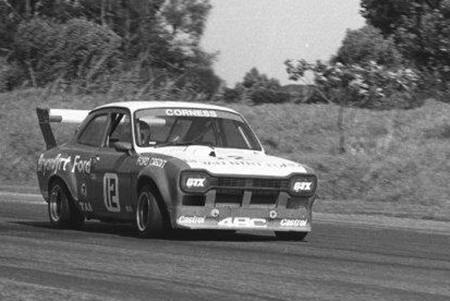We are all used to the highly drilled F1 teams we see on TV these days. In comes the F1 racecar, leaving three point something seconds later after changing four tyres.
With F1 drivers commanding incredibly high salaries (30 million USD is commonplace), the top F1 engineers are also very well paid to put together championship winning race cars.
With an F1 Grand Prix there are supporting races as a build up to the main event, and in the Australian GP of 1980, which was held at Calder Raceway (outside Melbourne) in Victoria, there was a race for Australian Sports Sedans.
 Home-built racer
Home-built racer
At that stage I was running a home-built space-framed Ford Escort Mk 1 Sports Sedan. While most of the cars in that group cost in the vicinity of $75,000, my little car cost $7,500. The front of the body shell came from an Escort bread van and the rear from a sedan, which were neatly cut and shut. The space-frame was of my design, as was the rear wing. The engine we put in for the race was a Mazda rotary replacing the unreliable Lotus Twin Cam and the gearbox was Datsun 240Z. It really was a home-built racer.
When I first decided I would like to run in the AGP meeting, I rang the organizers and asked for an entry form. I was then told “Don’t bother coming down. There’s only 30 spots on the grid and we’ve got 45 V8 sports sedans entered already.” Nothing daunted, I decided we would go anyway.
So after two days of towing we arrived at Calder Raceway, a circuit owned by one of Australia’s racing legends, Bob Jane. We set up our tent in the grassy area for supporting racecars and prepared for Qualifying.
The little Mk 1 Escort might have been home and hand-made, but the little car surprised many of the V8 engined cars by qualifying in 12th place on the Friday, well within the 30 car cut-off. We were very hopeful of a good placing in the first race on the Saturday. There was only one problem, it was starting to overheat.
Back in our grassy pit we really did not know what to do next. Two days from home, with an engine which had just been installed, and an engine we did not understand. However, the engine builder in Sydney said to pull the engine out and he would tell us what to check.
However, when on a grassy field, with no hoists or block and tackles what can you do? It was then the owner of Calder Raceway, Bob Jane, walked up and asked us what was wrong. When he heard of our plight he immediately offered us the use of his pit and equipment.
We pushed the little Escort down pit lane to Bob Jane’s pit. Right next door to the F1 Williams team! The team with Alan Jones the then World Champion. If little Escort could have puffed out its chest with pride, it would have.
Of course the Williams team engineers strolled next door to see what this homemade race car was doing in the Formula 1 pits. We explained the generosity of Bob Jane, and how we had come so far to race and the engine would not run properly.
“What is the temperature of the water going into and coming out of the radiator?” asked Alan Jones’ engineer Wayne Eckersley. We looked sheepish and informed him that we didn’t know.
He popped next door to the Williams pit and came back with little booklets of colored stickers. These were heat sensitive covering specific ranges. These days there is telemetry in F1, but in those days, this was the latest development. “Fire it up,” said Wayne and within two minutes he had the answer. “The radiator hasn’t enough cooling capacity,” was the diagnosis from the temperature gradients shown by the stickers. This was just magic, but unfortunately spelled the end of our F1 weekend. That problem could not be overcome on a race weekend, two days from home.
However, I have never forgotten the kindness shown to us by the circuit owner Bob Jane, and the friendliness and assistance of the Williams engineers, especially Wayne Eckersley. It may be 35 years ago now, but that is how motor racing used to be.




